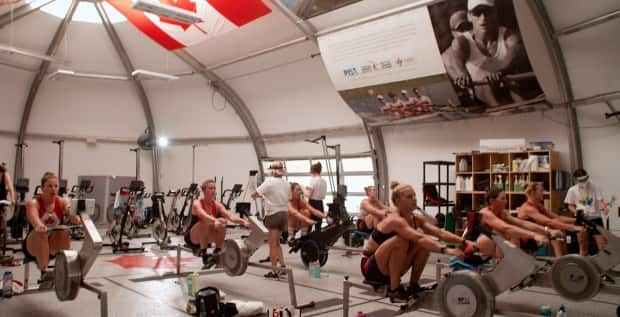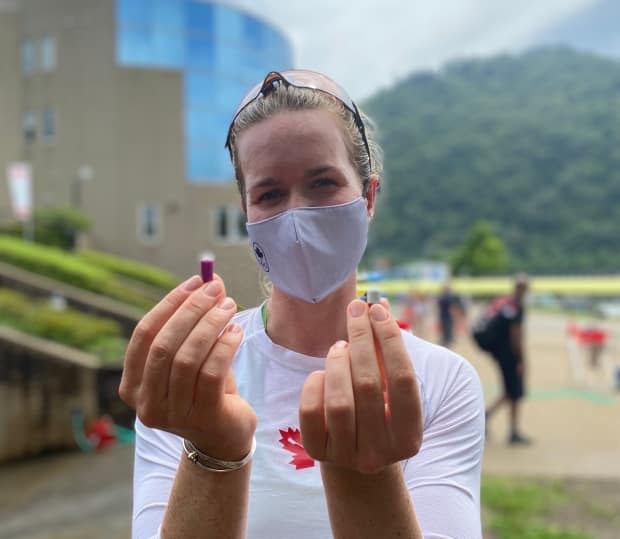How Canada's athletes are training for what could be the hottest Olympics

Of all the extraordinary circumstances faced by those competing at this year's Olympics, the one that could have the most direct impact on athletic performance is the weather.
In the run-up to the Tokyo Olympics, much of the public's attention has been on the pandemic that has pushed the Games back by a year and resulted in spectators being barred from events. However, extreme summer temperatures are among the top concerns for Olympic athletes and their trainers, who have had to find some creative ways to prepare.
The summer months in Tokyo can be so hot that the 1964 Summer Games there were held in October. With this year's events forging ahead this month, forecasters have predicted these could be the hottest Olympics to date, with temperatures reaching as high as the mid-30s Celsius.
For the Canadian women's eight rowing team, training to compete in that kind of heat has meant moving indoors, into a sweltering sports dome at the Canadian Sport Institute Pacific in Victoria, B.C. On an otherwise cool summer day, team pathologist Wendy Pethick cranked up a huge heater, helping push the dome's indoor temperature up to around 35 C.

"The whole goal for heat acclimation is to try to impose a thermal stress for a given period of time," said Pethick, with the intent of pushing up the athletes' baseline core temperatures by about a degree, to a maximum of 38.5 C.
"Because we don't have the temperatures here in Canada," Pethick said, doing this kind of training ahead of the games can help the athletes' bodies learn to deal with that kind of heat and "gives them a little bit of an advantage."
The results look deeply uncomfortable. As the rowers grind out a gruelling 90-minute workout on rowing machines and stationary bikes, sweat slides off their bodies and splashes into pools on the floor beneath them. Pop music is pumped loudly on speakers to keep morale up.
Team member Madison Mailey said she and her teammates generally drink "around three to four litres" of water during a session. They're all weighed before and after, so they know how much fluid they lose.
"It's quite gross to think about your body sweating out three to four litres of water. But it's real," she said.

Since individuals deal slightly differently with heat, Pethick and her colleagues move around the room, checking in with each athlete to gauge their condition.
One of the tools they employ is a tiny thermometer in the form of a pill. The athletes are asked to swallow it a few hours in advance of their training session, and it transmits data about their internal body temperature.
"As soon as the athletes get to 38.5 [Celsius], we just try to maintain that for as much of the session as we possibly can. And we know from the literature and from the research that by applying that amount of thermal stress, we're going to get full adaptation," Pethick said.
High-level athletes like the women's eight rowing team have "very well-developed sweat mechanisms," she said. "And heat acclimation augments that process."
The pill also helps ensure each athlete's safety during training.
"If we have an athlete that heats up really quickly, then we know that we can back off on the work that they're doing so that we don't overcook them," she said.

While the actual rowing competitions themselves only last around six minutes, Pethick says, the athletes are working at maximum capacity. That means that while dehydration is less of a concern during a race, they can still overheat.
"The real difficulty is going to be the humidity," Pethick said. "What that does is it effectively shuts down our most effective heat loss avenue, which is evaporation of sweat."
When the body can't thermo-regulate, she says, "you get into things like heat stroke and heat exhaustion, which can be very serious."
Racing in a Laser Radial dinghy means Sailor Sarah Douglas not only has to contend with the heat in the air, but also from splashing water, which she says could reach as high as 28 C in Tokyo.
Twice a week for around 20 to 40 minutes, she has been training on an exercise bike in a heat chamber at the Canadian Sport Institute Ontario in Toronto. Occasionally, she has posted videos of the sweaty outcome to social media.
"It's feeling like an oven," she said in a selfie video taken inside the chamber, where the temperature gauge read 33.6 C, with 65 per cent humidity.
WATCH | Canadian sailor Sarah Douglas shows what an Olympic training session in a heat chamber is like:
Afterward, she wrings out her soaking wet shirt over a sink. "OK, this is how hot it is," she said, as sweat pours out.
Discomfort is something athletes are used to and train for, but high heat can be especially dangerous for those competing outdoors for long periods of time. That's why the International Olympic Committee (IOC) moved distance races, such as the marathons, to Sapporo, around 800 km north of Tokyo. Temperatures there are expected to be a few degrees cooler, but still hot.
Before heading there, Canadian marathon runner Malindi Elmore has been training outside in the midday heat in her hometown of Kelowna, B.C. The goal is to acclimatize, but she says the challenge for runners can be as much about training the mind as it is physical.
"It's in our minds as athletes [that] we want to always do things at our very best," she said. "But the heat is legitimately a factor, and we need to back off 10 or 15 seconds a kilometre to adjust for the pace."
Elmore says the overall pace of a race will "naturally adjust" when it's hot. She says those runners who don't will "pay a really heavy price."
Brent Lakatos, a Canadian wheelchair racer, will also be competing outdoors in Japan in the Paralympics. He normally lives with his wife in the United Kingdom, which doesn't have the kind of heat he needs in order to prepare to compete in the sunshine in Japan. So he has been training in Spain in order to acclimatize.
Upon his return to the U.K. before heading to the Games, he said, he'll continue his training inside a do-it-yourself heat chamber in his garage.
"I'm going to be getting a humidifier that grocery stores use — so, a fairly strong one — and setting that up inside my garage along with a heater," he said.

Wendy Pethick says Paralympians sometimes require highly individualized training plans for heat mitigation. For instance, athletes with spinal cord injuries may have a diminished capacity to sweat, she says.
"And so for those athletes, we've looked at a number of different ways for cooling."
They include vests filled with ice that can be worn before or after a competition, as well as ice slushies that can be ingested to help lower the body's core temperature.
Pethick says she was "a little bit" surprised by the choice of Tokyo in mid-summer for these Games. But she added that, "for any Summer Olympics on any given day, it could be temperature extremes. And so I think athletes and coaches need to be prepared for that."
It's a lesson summer athletes will likely need to heed into the future, as rising temperatures mean Summer Games could be increasingly hot in many parts of the world. Tokyo, in so many ways, is a testing ground pushing athletes to adapt.
Watch full episodes of The National on CBC Gem, the CBC's streaming service.

